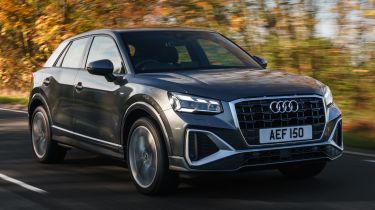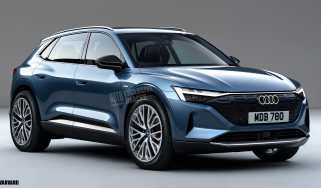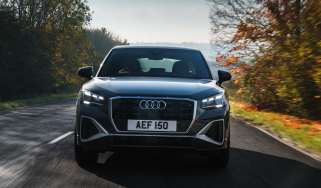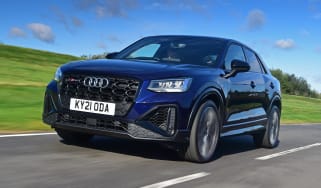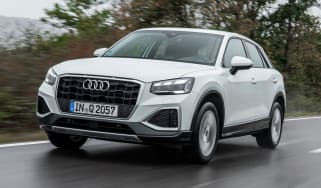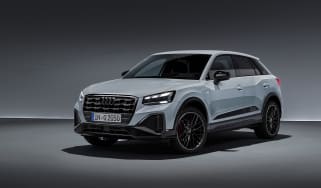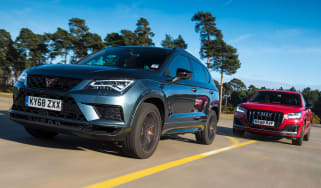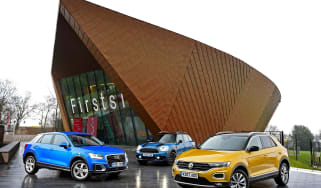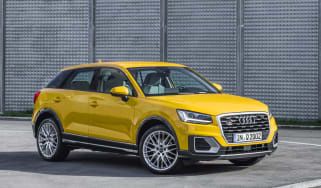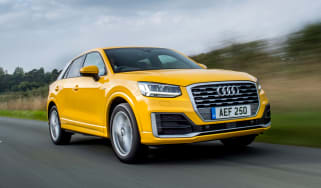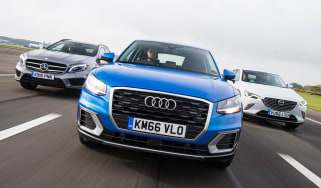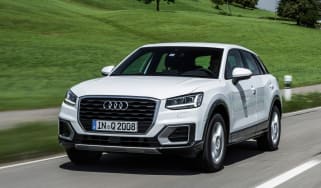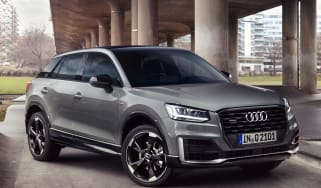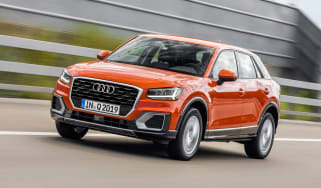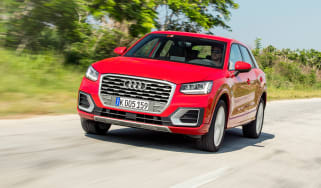Audi Q2 review: premium small SUV with plenty of style
The Audi Q2 is a stylish crossover with big car features, but it’s dated and less well-finished than you might expect

Audi has an extremely wide range of SUVs these days and kicking off the lineup is the Q2, which aims to offer the same style of its larger siblings in a compact crossover package. It sits below the Q3, Q5, Q7 and Q8 in the internal-combustion engined side of Audi’s SUV range, with the Q4 e-tron, Q6 e-tron and Q8 e-tron providing the all-electric alternatives.
The Q2 sits in the same class as the BMW X2 and Mercedes GLA, but having launched back in 2017, the Audi is feeling its age compared to its relatively fresh rivals. In some areas that’s a good thing though, because inside you get lots of old-school physical buttons and good overall ergonomics. There’s a pretty firm ride, however, and the technology on entry-level models is a bit low-rent for a premium SUV.
Still, there’s lots to like about the Audi. It’s good to drive, roomy and offers a range of personalisation options. It’s also backed by some tempting finance deals. You’ll just need to watch the options list to stop the price spiralling out of control.
About the Audi Q2
You have to be impressed at the speed with which Audi has filled and/or helped to invent the wide range of SUV niches we’re blessed with today. The company hadn’t built an SUV before the game-changing Q7 first arrived in 2005, and nowadays they’ve got a desirable option in almost every segment of the sector you can think of.
Used - available now
The Q2 fits into the line-up beneath the Q3 and Q5 models - at least for now. Audi announced in early 2022 that it would axe the small crossover at the end of its current life-cycle, with no direct successor planned and its focus switching to larger models and full electrification. Audi also plans on making every even-numbered car an EV.
The Q2 is pretty close to the Q3 in size as both share a platform related to that of the previous-generation A3 hatchback. Interestingly, while the success of the Audi SUV line-up has been built to some extent off the back of its reputation for quattro four-wheel drive, it’s a feature that’s only of passing interest to buyers of the Q2. Most of the line-up is front-wheel drive only, and only the most powerful SQ2 variants receive a quattro drivetrain.
The engine range features two petrol engines, with diesel power no longer available: a 109bhp 1.0 TFSI three-cylinder turbo, badged 30 TFSI, and a 148bhp 1.5 TFSI turbo four-cylinder, badged 35 TFSI.
You won't find the 187bhp 2.0 TFSI 40 TFSI model on the price list any longer, or the 114bhp 1.6 TDI and 148bhp 2.0 TDI, badged 30 TDI and 35 TDI respectively.
All models get a six-speed manual, while the 35 TFSI can also be had with Audi's seven-speed S tronic twin-clutch gearbox. Performance fans will be better served by the sporty Audi SQ2 model, which brings a 296bhp 2.0-litre petrol engine, quattro four-wheel drive and a DSG gearbox. In mechanical terms it's similar to the previous-generation Audi S3 and Volkswagen Golf R.
The old Technik trim level was removed so the cheapest Q2 is based on the Sport model. These are sparsely equipped in comparison to the rest of the range, but they do get 17-inch alloy wheels, sport seats and an 8.3-inch central screen and Audi’s ‘Virtual Cockpit’.
S line models feature a different look, courtesy of body coloured wheelarches, a silver grille and redesigned bumpers. 18-inch wheels, full LED lights with scrolling indicators at the rear, leather seats and sports suspension are also included. However, in our experience the sports suspension is too stiff to be comfortable on British roads, so we'd recommend switching to comfort suspension, which you can do at no extra cost. S line cars also get LED interior lighting that bathes the cabin in gentle light and illuminates various trim elements. There’s also a free choice between silver or white for the third-pillar ‘blade’.
Black Edition models add 19-inch black alloys and a gloss black exterior pack, while the top-level Vorsprung trim no longer features on the price list.
One highlight of the Q2 is that it comes with Audi’s Pre Sense safety kit. It's standard on all models and includes Autonomous Emergency Braking, which will put the brakes on if the sensors detect a pedestrian stepping out in front of the car. Other helpful driver assist options include adaptive cruise control, lane departure warning and lane keep assistance, plus traffic sign recognition and rear traffic alert when you’re reversing.
How much does the Audi Q2 cost?
With the loss of the basic Technik trim level the Q2’s starting price increased from £24,000 to around £28,000, with S Line starting at just over £30,000 and Black Edition starting from around £32,000. The sporty SQ2 starts at over £45,000.
Engines, performance and drive
Under the skin, the Audi Q2 is based on the VW Group’s scalable MQB platform. It’s the older MQB A1 version so it’s the same platform used on the old Audi A3 and Volkswagen Golf, despite a lifted ride height, it’s no surprise to find the Q2 drives in a similar way to its hatchback cousins.
Audi uses the phrase ‘go-kart feel’ to describe the Q2, a phrase it’s borrowed from MINI. Turn into a corner and you’ll find the Audi is poised and stable, but the steering lacks the weight and feedback of a BMW X1. It is quick, helping boost the feeling of agility, but the Q2 relies heavily on driver aids and the torque vectoring system is particularly intrusive. The Audi also has a firm ride. It never becomes crashy, but the car follows bumps that more comfortable rivals manage to filter out.
The Q2's steering comes from the old Audi S3 model and it feels meaty enough to put a smile on your face. It's not too heavy, making it an easy car to drive around town and in spite of the car’s short wheelbase and high centre of gravity, there’s not too much body roll when you go around corners – helped by the car’s wide track. The raised driving position makes it easy to place around town, but the pedals sit near to you in a more typical SUV style, which might not be to the tastes of those looking for a sporty feel. This is where the similarly-priced but larger Cupra Formentor feels like a much more focused offering with its more reclined hatchback-like position.
The steering is fast and light, with a consistent weight. There’s very little communication from the chassis, though, while the systems sometimes feel as if they hold the car back in corners, fighting what you’re asking it to do.
The trade-off for this nimble handling is a very firm ride. On bumpy roads the Q2 doesn’t strike the same balance as a Mazda CX-30, for example. It feels firmer and less composed over rippled surfaces, which means that although it handles well thanks to the firmer set-up, it does get disturbed more by mid-corner bumps and doesn’t have the same level of compliance as the CX-30 when the chassis is loaded up. It responds to rippled surfaces more abruptly than the CX-30, too, so isn’t as refined when cruising.
Alongside the more knobbly ride there are one or two other factors that mark down the Q2. For example, the brake pedal feels far too sensitive, which sometimes makes it difficult to bring the car to a smooth stop.
The range-topping, all-wheel drive SQ2 offers predictable, usable performance in all conditions; 0-62mph takes just 4.9 seconds and it has buckets of in-gear shove. The car can shuffle power around its four wheels – up to 100 per cent to the rear wheels if needed – but it's not as playful as some of the best hot hatchbacks on sale. However, if outright pace is more of a concern, the SQ2 is a great choice.
Although much of the Q2 tech is on the options list, there’s plenty of advanced safety kit as standard. Audi’s pre sense safety kit is standard, which includes Autonomous Emergency Braking and will also put the anchors on if it spots a pedestrian stepping out in front of the car.
Engines, 0-60 acceleration and top speed
The 1.0 TFSI has been taken from other cars in the VW Group stable and serves up 109bhp here; that’s almost as much as the (now discontinued) 1.6 TDI model, but engine refinement is stronger, and with a turbo to boost the output, the potential for decent performance and economy in daily use is good. The 1.0-litre revs smoothly, but feels strangled at the top end, although the trade-off is that the turbo delivers decent torque in the middle of the rev range.
The 1.5 TFSI is sweet revving and quiet when you’re cruising on the motorway. It’s also got enough firepower to fulfil the car’s sporty brief. The engine is available with a six-speed manual gearbox or a seven-speed S tronic dual-clutch automatic across all trim levels, although you’ll pay a marginal penalty in CO2 emissions and economy if you opt for the auto. Even so the S tronic gearbox is an excellent choice as it’s quick to react and works smoothly, even when you kick down. And you can take control yourself with paddles behind the steering wheel, although they’re small, plasticky and never deliver rapid-fire changes.
While that’s not exceptional, you’ll find that in most situations the Audi will comfortably keep pace with traffic. Better still, maximum torque is delivered at just 1,500rpm, so you don’t have to extend the rather gruff and thrashy engine to make decent progress. But, while our car’s six-speed box had a generally slick action, our testers found that engaging sixth gear often required some serious muscle. The S tronic gearbox is a nicer partner – this dual-clutch seven-speed unit reacts quickly and smoothly and can be given a sportier bent if you select the optional Audi drive select system.
MPG, CO2 and running costs
A selection of economical Volkswagen Group engines should ensure that the Audi Q2 delivers reasonable fuel economy. If rock-bottom running costs are key, then look to the older frugal diesel options – especially the 2.0 TDI.
The entry-level 1.0 TFSI turbo three cylinder has claimed economy of up to 48.7mpg and emissions as little as 131g/km. The 1.5-litre TFSI petrol features cylinder on demand technology, which shuts down two of its four cylinders when cruising to save fuel. As a result, the 1.5 is only marginally poorer than the 1.0 TFSI, returning 47.9mpg and emitting 133g/km of CO2. However, it's worth bearing in mind that moving up to an S line model with larger wheels pegs back economy and emissions.
Diesel power is no longer available, but if you track down a used example then you'll find that the 114bhp 2.0 TDI fares better than the 1.0 TFSI in efficiency terms - Audi claims the oil-burner is capable of up to 58.9mpg, with CO2 emissions from 125g/km. At the other end of the scale, the sporty SQ2 models return an official figure of 33.2mpg and emit a best of 192g/km of CO2. Lean on the SQ2’s power often and you’ll see that figure drop to the mid-20s however.
Insurance groups
Insurance groups for the Audi Q2 currently start from group 14E for an entry-level Q2 1.6 TDI and 1.0 TFSI Technik models. A 1.5-litre TFSI in flashy Vorsprung spec sits in group 28E, while the performance-focused SQ2 is in group 37E.
Depreciation
The Audi Q2 stacks up pretty well when it comes to residual values, with an average of 58 per cent of its original list price retained over three-years and 36,000 miles. The best performer is the 35 TFSI model in S line trim fitted with the £1,295 Technology pack which holds onto around 60 per cent of its showroom value after 36-months of motoring.
To get an accurate valuation on a specific model check out our Free Car Valuation tool...
Interior, design and technology
Like a lot of VW Group products, the Audi Q2 is based on the scalable MQB architecture. Not only is the chassis light and strong, giving sharp handling and refinement, its flexibility has allowed designers freedom to create distinctive styles. Yet the Q2 takes a more conventional approach, borrowing cues from models like the Q7 and TT coupe.
The Q2 is available with a number of customisation options. Not only is there a wide range of alloy wheel designs, you can also choose contrasting colours for the C-pillar inserts. It's a real stand-out feature of the Q2 that’s not unlike the side panels found on the R8 supercar, coming in differing shades of grey, silver and black depending on your chosen trim level. It’s not just for design, either – the floating blade has aerodynamic properties, too.
Alloy wheel sizes range from 17s on Sports and 18s on S line models. Black Edition models come on 19s, which are also available as options on other trims, but beware that the bigger the wheel, the bigger the bumps you’ll feel, especially in the back and on Sport rather than Comfort suspension.
The Q2’s interior quality is solid enough, especially against rival small SUVs and many other cars at the price, too. There are soft plastics where you see and touch most, although Audi will admit to saving money where you won’t notice it. The swathes of plastic on the door cards and some flimsy material in the centre console let it down a bit.
Every Q2 gets a dash-top screen although you have to head for the options list to fill it with interesting stuff like sat-nav. And if you really want to push the boat out, you can opt for Audi’s impressive 12.3-inch Virtual Cockpit – a TFT dash display that replaces conventional dials and gives you further options to personalise what you can see.
Sat-nav, stereo and infotainment
Audi’s MMI Navigation system is lifted straight from the manufacturer’s other models, giving the Q2’s cabin plenty of premium appeal, despite some questions over the quality of materials used. The graphics on the seven-inch screen are relatively sharp, but this was only offered on the old entry-level Technik. Sport comes as standard with the 12.3-inch Virtual Cockpit digital dash display.
We like the rotary wheel fitted on the transmission tunnel that controls the central screen. It’s intuitive and chunky so you rarely input incorrect commands and that rotary wheel also features as standard a touchpad within. After a few goes you get used to drawing each letter or number on the touchpad and it’s pretty clever at picking up the character you intend - even if your finger writing isn’t the tidiest.
MMI Navigation features three months of connected services, giving information on local searches, fuel prices, weather and even social media. Alongside this, Apple CarPlay and Android Auto connectivity is standard, further improving the integration with your smartphone. The SQ2 comes with a smartphone charging pad, but it’s annoyingly located underneath the armrest.
Practicality, comfort and boot space
The Audi Q2's interior is relatively spacious considering its small footprint – Audi claims similar interior space to an A3 and we wouldn’t argue. Of course, the higher roofline and more upright seating positions help, but you actually sit slightly lower in the Q2 than you do in other small SUVs, helping to give the car the claimed ‘go kart feel’ that Audi mentions.
Dimensions and size
At 4121mm long, the Q2 is 92 longer than an Audi A1 and 222mm shorter than an A3. Among SUVs, it’s a smidge shorter than a Nissan Juke and the best part of a school ruler shorter than its big brother, the Audi Q3. So we can safely say it qualifies as a small SUV.
And the problem with small SUVs is they can look a bit dumpy, while a short wheelbase and high centre of gravity combination can play havoc with ride and handling. Thankfully, Audi seems to have come to terms with both.
Leg room, head room & passenger space
Front seats have loads of adjustment, so the very smallest and the very tallest drivers will be able to get comfortable, especially with a steering wheel that adjusts up and down, as well as in and out. Headroom is good, too, even in the rear where Audi’s designers have worked hard to keep the roofline low for a sportier look – there’s a distinct hollowing out of the roofline at the back but a six foot passenger can sit behind a six foot driver in reasonable comfort. Your knees will just about be brushing the back of the front seats, but you won’t have to splay your legs out.
Passengers of a more average height will have no complaints in the back, unless they’re asked to sit in the middle of the back row. As usual, that’s a raw deal: narrow, hard and with less space for feet.
The larger side windows and light headlining help create an airier atmosphere, but the Audi suffers from small door openings, making access to the rear bench a little tricky.
Boot space
Visibility is good all round in spite of a fairly shallow rear screen at the back. However, the boot door (which can be powered for another tick on the options list) opens wide to reveal plenty of space. At 405-litres (rising to 1,050 litres with the rear seats folded) it’s bigger than an A3 Sportback's, but some way shy of the Hyundai Kona’s 466-litres and 123 litres off the Audi Q3.
The boot floor can be raised slightly so the floor is flat when the seats fold, and you can also opt for a 40/20/40 split for easy through loading of longer items.
Storage is reasonable inside, too, with decent-sized door bins and glove box, plus handy places for cups or phones in between the seats. There’s also a slot to rest the key in, as the Q2 comes with a keyless system where you don’t have to physically turn the key to start.
Reliability and safety
The Audi Q2 comes with an impressive roster of safety kit as standard, plus some super-advanced stuff that’s on the options list. Euro NCAP tested the Q2 in 2016 and awarded it a full five-star rating, with adult and child occupant protection scores of 93 per cent and 86 per cent, respectively.
Audi’s pre sense safety kit is standard and includes Autonomous Emergency Braking, which will put the anchors on if it spots a pedestrian stepping out in front of the car.
Other big car options include adaptive cruise control, lane departure warnings and lane-keeping assist, plus traffic sign recognition and alerts if there’s traffic coming when you’re reversing.
Plus, of course, there is set to be the usual array of airbags as well as standard traction and stability controls and anti-lock brakes.
Owners are keen on Audi’s upmarket image, but responses from customers have revealed that they are less keen on other aspects of the ownership experience. The manufacturer finished in 30th place out of 32 car makers in our 2023 Driver Power brand survey, with a one-place rise to 22nd in 2022. The Q2 was voted into 53rd position on a 75-car list in 2021's best car to own poll, following up with 55th spot overall in 2022, although it didn’t feature in 2023.
Warranty
The standard Audi warranty lasts for three years or 60,000 miles, although the mileage cap is removed in years one and two.
Servicing
Audi service schedules tend to range from 9,000 miles for minor checks to 19,000 miles for a full service. To keep a check on costs, Audi dealers will sell you one of many fixed-price deals.
Audi Q2 Alternatives
As it's a premium model, rivals for the Q2 are from the higher end of the small crossover class. Chief among these rivals are the BMW X1 and X2 twins, the Mercedes GLA and Range Rover Evoque. All of those have since launched with brand-new iterations, however, making them a fair bit more expensive than the Audi. Elsewhere, the MINI Countryman is worth considering, while high-end versions of the Hyundai Kona and Jeep Avenger offer a lot of kit for similar money to basic versions of the Q2.

